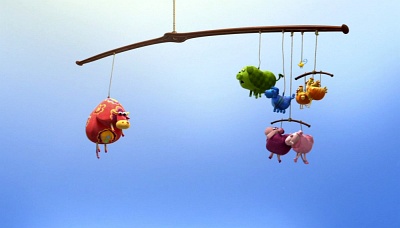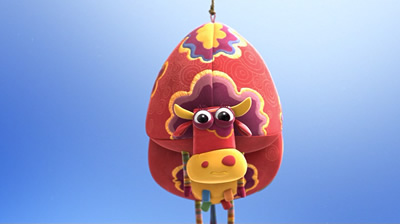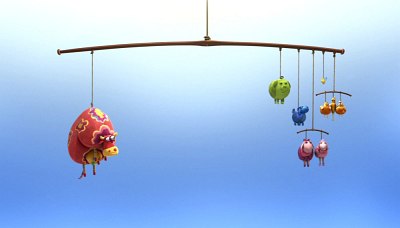Mobile
Film info
Title: Mobile
Running time: 6 min.
Director: Verena Fels
Country of origin: Germany, 2010
Language: No dialogue
Genre: Animation
Suggested age group: 6-7 years
Synopsis
A cow hangs alone on one side of a mobile while all the other animals are on the other side. She really wants to have a friend, and the only one who does not refuse her friendship is a very little mouse...
Main themes
Stereotypes, love and relationships
The need for persistence when you are sure of what you want
The need to overcome difficulties in everyday life to affirm your rights
Activities
| A. Before | the film: | |||
| Exercise 1 | Making a mobile | individual | 30 min. | |
| B. Introduction + showing the film: | together | 10 min. | ||
| C. After the film: | ||||
| Exercise 2 | Listen to the song | together | 10 min. | |
| Exercise 3 | A box of crayons | individual/together | 30 min. | |
A: Before the film
Exercise 1 Making a mobile
For a better understanding of the (physical) difficulties in the film, it is a good idea to let the pupils build a mobile beforehand. This way they experience the fragility of balance that comes with it themselves.
Explain to the pupils that mobiles are a type of sculpture in which parts move, often activated by air currents. Mobiles are also referred to as kinetic art, because they incorporate actual movement as part of the design. The mobile was invented by an American sculptor called Alexander Calder in the early 20th century. He began by developing a new method of sculpting: by bending and twisting wire, he essentially "drew" three-dimensional figures in space. The suspended, abstract elements move and balance in changing harmony.
There are many different ways to create your own mobile. One is twisting two wire clothes hangers together and suspending different objects from strings on these intertwined hangers. For this exercise, make sure the children use objects that differ in weight, so they experience how this tips the balance of the mobile.
B: Introduction and showing the film
Show the pupils the picture of the cow from MOBILE:
Who knows what colours a cow can be?
What colour is this cow?
Do you like it?
How do you think the other animals will feel about that?
Let’s watch the film and find out.
C: After the film
Exercise 2: Listen to the song
At the beginning of the film (and again at the end) we hear a Spanish tango song. Read the text of the song out loud to the pupils (you can download the worksheet).
From the sky one morning,
Solario woke up,
Forgotten by the others,
She felt how she was suffering.
Sadness was killing her,
But she was willing to,
To be owner of her fate
To be a cow and nothing else.
Who thinks they can explain what this means?
How does the cow feel? Why? (she feels alone, excluded from the other animals)
What does she do to try and change how she feels?
Does it work?
She’s a very brave and persistent cow!
In the end it doesn’t matter what you look like or who you love, as long as you’re happy!
Note
There is also a picture book from the film available via amazon.de.
Exercise 3: A box of crayons
Give each pupil two sheets of paper and ask them to pick one crayon out of the box. Ask them to draw a picture of a cow using only this colour on one of the sheets.
After about 5 minutes, get them to draw a picture of another cow on the second sheet, using as many colours as they like. When they are done ask them which picture they like best. Which cows shall we put up on the wall?
Most pupils will say they like the multi coloured one the best (though of course it is OK if somebody chooses the plain coloured cow).
Wouldn’t the world be very boring if we were all like the picture drawn with only one crayon?
The diversity in the world makes it like a wonderful box of crayons with all different colours.
Next read them the poem The Crayon Box that Talked. (You can download a worksheet with the original English version of the poem.)
The Crayon Box That Talked
While walking into a toy store the day before today
I overheard a crayon box with many things to say"I don't like Red!" said Yellow and Green said "Nor do I"
"And no one here likes Orange but no one knows just why"
"We are a box of crayons that doesn't get along
Said Blue to all the others "Something here is wrong"
Well, I bought that box of crayons and took it home with me
And laid out all the colours so the crayons all could see
They watched me as I coloured with Red and Blue and Green
And Black and White and Orange and every colour in between
They watched as Green became the grass and Blue became the sky
The Yellow sun was shining bright on White clouds drifting by
Colours changing as they touched becoming something new
They watched me as I coloured - they watched me till I was through
And when I finally finished I began to walk away
And as I did the crayon box had something more to say"I do like Red!" said Yellow and Green said, "so do I"
And Blue you were terrific! So high up in the sky
"We are a box of crayons each one of us unique
But when we get together the picture is more complete"(Shane DeRolf)
Discuss the poem with your pupils.
Isn’t it stupid that the crayons do not like each other just because of their colour?
Each crayon has something special to offer to the picture: green for the grass, blue for the sky, yellow for the sun.
Ask them to brainstorm the reasons why it is important to accept people who are different from us. Write their answers on the blackboard.
We can learn a lot from the crayons. They all are different colours, but they all exist very nicely in the same box!




